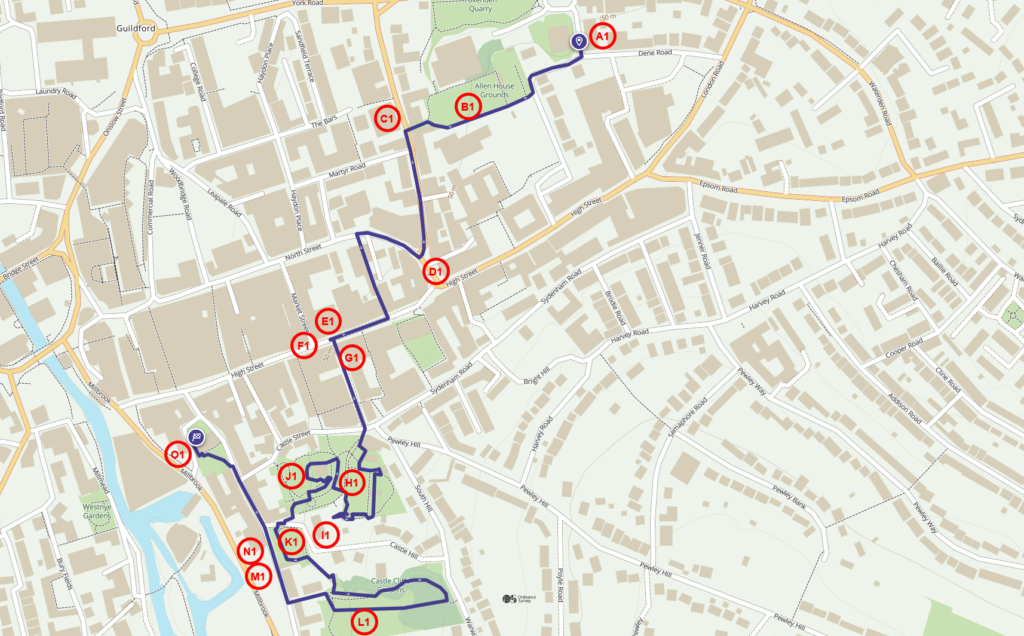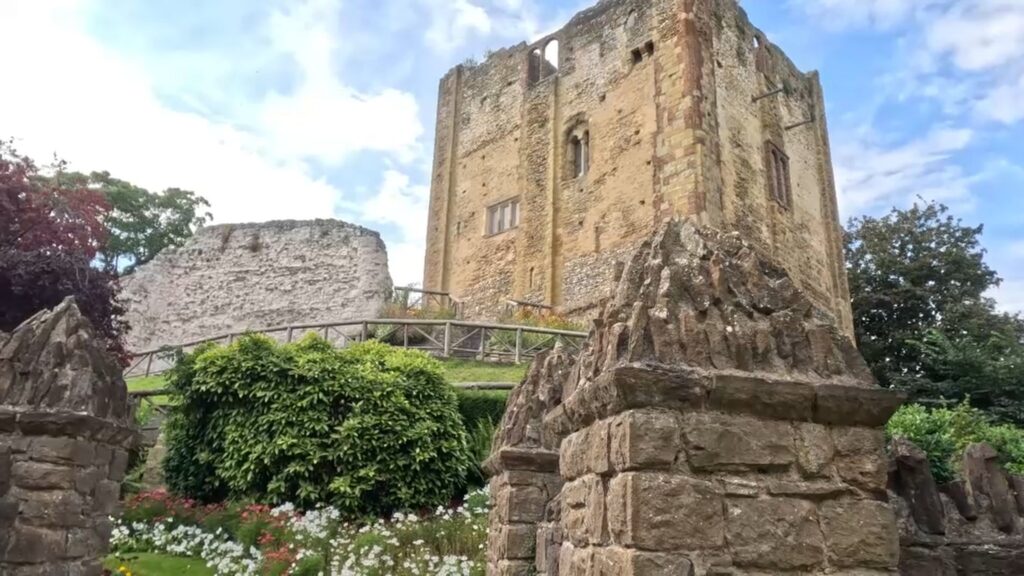Our journey continues in Guildford the iconic sites along its High Street and searching out charming and quaint back streets.
Follow the entire walk on . The route map is available on
.

Waypoints
Waypoints
A1: St Joseph Church
B1: Allen House Ground
C1: Grace Baptist Church
D1: North Street
E1: Guildhall
F1: High Street
G1: Tunsgate
H1: Castle Bowling Green
I1: Statue of Alice through the Looking Glass.
J1: Guildford Castle
K1: Castle Cliff Garden
L1: Racks Court
M1: Castle Arch
N1: Guildford Museum
O1: St Mary’s Church
Begin at St Joseph Catholic Church at Eastgate Gardens. If you’re arriving by car, consider parking at the G Live or York Road car park. Follow the road that banks right and turn left into Allen House Ground. Usually, this is a serene spot within Guildford Town Centre, but occasionally, it’s animated by spirited teenagers playing basketball. Nearby, you’ll spot the Grace Baptist Church. The church’s roots can be traced back to 1645, and perhaps even earlier.
Continue walking along Chertsy street toward North Street. On Fridays or Saturdays, between 8:30 am and 5 pm, the bustling North Street market beckons. With over 20 stalls selling everything from fresh produce to clothing and jewellery, it’s an essential stop for shoppers. Venture left into the narrow Jeffery Passage that connect you to the famous Guildford High Street.
High Street is a historical gem. Today, it’s brimming with independent boutiques, stores, cafes, and bars catering to both residents and tourists. Regular events—including craft fairs, the Guildford half marathon, and street performances—transform this street into a lively community space.
Turning right as you leave Jeffery Passage on to the cobbled street past the Guildhall, an ancient building in which the Approved Men of Guildford met to administer the affairs of the Borough. It has a famous clock dating from 1683.
Across the road is the Tunsgate Arch featuring Doric columns was built in 1818 as an entrance to the Corn Exchange. Directly across is The Guildhall, an ancient edifice where the town’s officials once convened.
Step beneath the archways and stroll towards Castle Square on a pedestrian path flanked by cafes and restaurants. On sunny days, you’ll find the path bustling with folks basking in the rare British sunlight, a cherished aspect of the UK. At the end to the walkway, glance at the Castle Gardens and the lower medieval town. Cross Castle Streed toward the Hare March, a stylish brasserie with a decked terrace. To the right is the Castle Bowling Green, which has been around since at least 1739. The Castle Grounds, transformed into Victorian pleasure gardens in the 19th century.
Take a leisurely walk along the left perimeter of the bowling lawn, passing under the shade of large trees. On the far side wall, you will see a partially concealed path that leads to a small garden containing the status of Alice Through the Looking Glass. This was created in memory of Lewis Carroll, the famous children’s author.
Retrace your steps back to the Castle Grounds and then turn left, following the pavement as it winds down into an underpass which opens up with an imposing view of the Great Tower of Guildford Castle straight ahead. Established by the Normans in the 12th century, the Great Tower predominantly served as a prison. It was restored in 2004. Today, if open, the Tower provides a glimpse into its history and a panoramic view.
The castle gardens, known for their vivid flowers set against meticulously manicured lawns of the castle ground, offer a picturesque view. Remember to bring your camera!
Head toward the exit on the left. Crossing Castle Hill into the Castle Cliff Garden, which was once a part of the expansive Guildford Castle. Overlooking these gardens is The Chestnuts, which once housed Lewis Carroll.
Head south towards the far side of the garden with ruins of a wall and trace the path leading upslope. You find yourself at the top of an open staircase leading into Racks Court. Covering no more than a hectare, Racks Court boasts rolling landscapes, mature trees, and open fields. It’s like a miniature version of the Surrey countryside, providing an oasis from the lively activity of Guildford. (Apparently, there were some chalk caves at Racks Court. Let us know if you can find their entrances. We couldn’t!)
Once you are adequately rested, head toward the houses and turn right into Castle Street. In 50 metres you see Castle Arch over Castle Hill. The Arch, built c. 1256, was the main entrance to the castle and once boasted its own portcullis. Next to the Castle Arch is the Guildford Museum, which opened in 1898. Today, it holds artefacts from Guildford’s history dating back to prehistoric times.
Further along Castle Street on the left is St Mary’s Church, the town’s oldest structure and has an unusual layout for a church built on several levels on the side of a hill. The present church was probably built in stone around 950. The tower is the earliest part. The rest of the church was added in stages over the following three hundred years. Fragments of medieval wall paintings of about 1200 survive, and a tiny piece dates back to around late Saxon (before 1066).
In our next video, we’ll resume our tour around Guildford Town Centre. Starting from St. Mary’s Church, we’ll guide you along Guildford’s primary streets and introduce you to hidden gems away from the usual tourist path.

